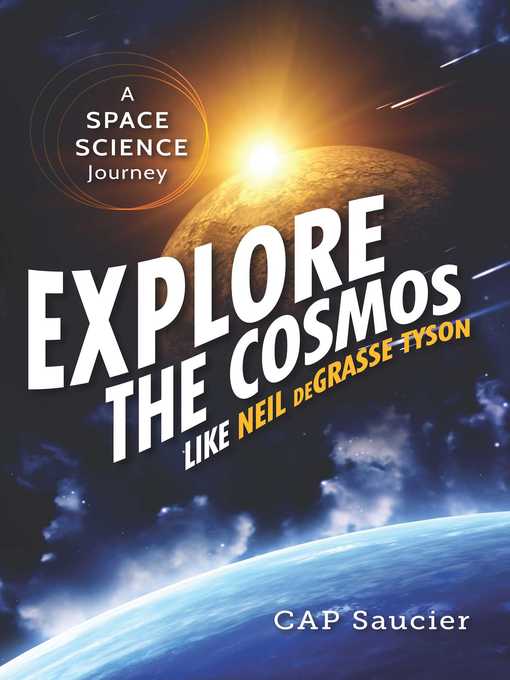
Explore the Cosmos Like Neil deGrasse Tyson
A Space Science Journey
کتاب های مرتبط
- اطلاعات
- نقد و بررسی
- دیدگاه کاربران
نقد و بررسی

December 22, 2014
This hybrid combines a biography of prominent astrophysicist Neil deGrasse Tyson with an introduction to the study of physics and the cosmos. In addition to covering Tyson’s childhood, adolescence, education, and work, Saucier delves into the social climate of his upbringing: “People often wonder why Neil did not try to be an astronaut. In the 1960s, astronauts were all white men with crew cuts. There were no women or black astronauts.” Oddly, while Saucier met with Tyson while writing the book, she often eschews direct quotes in favor of awkward paraphrases (“Neil’s favorite blues performer is Buddy Guy because Neil really can feel what Buddy is singing”). Profiles of scientists that informed Tyson’s work are interspersed, as are varied topics in astrophysics, but inelegant prose lets down this effort. A glossary and source notes are included. Ages 8–12.

December 15, 2014
A tour of the solar system and the cosmos beyond, with a celebrity guide standing by.Saucier opens with two chapters of biography and later shoehorns in a third. Forcibly interspersed are capsule histories of astronomy and the universe, discussions of galaxy and star types, a progression past our astronomical neighbors from the sun to the Oort cloud, and a final omnium-gatherum look at exoplanets, asteroid impacts on Earth and like matters of current interest. Tyson's role in all this is to be paraphrased, often inanely: "Neil reassures us that dark matter does not interfere with Earth or humans as we move around on our planet's surface"; "Neil hopes Earth does not end up like Venus...." Not only is the narrative further hampered by clumsy prose, but the author leaves indigo out of the visible spectrum, makes conflicting claims about whether or not Ceres is the only round asteroid, and confusingly asserts that Saturn's "surface" (which it doesn't have, at least not a solid one) is less colorful than Jupiter's due to "a thick layer of clouds" (as if Jupiter lacks the same). Though sometimes misplaced, the many photos, both of space taken by the Hubble Space Telescope and of Tyson at various ages, are a plus but can't compensate for the book's many liabilities. Better ventures into the high frontier abound-and so do better profiles of our leading living science popularizer. (notes, glossary, bibliography, no index) (Nonfiction. 11-13)
COPYRIGHT(2014) Kirkus Reviews, ALL RIGHTS RESERVED.

February 1, 2015
Gr 5-8-Combining biographical information about Neil deGrasse Tyson, the popular American astrophysicist, with an exploration of space science, this work seeks to interest middle school readers in both. Tyson's fascination with the universe came early, and his enthusiasm is exhilarating and contagious. His many quotes frame the chapters on familiar planets and the farther, less familiar outer reaches of space. Up-to-date information culled from unmanned space probes makes this work useful for research. However, the organization of the material, interspersing biographical tidbits with astronomical data, results in an often confusing reading experience. The author's habit of referring to Tyson by his first name and including comments about his opinions on music, films, and wine, as well as other fascinating but irrelevant facts, dilute interest in the cosmos-related material. A good bibliography and glossary will help those doing school reports, and the chapter notes are often beneficial. VERDICT Of value for curriculum-related research.-Eva Elisabeth VonAncken, formerly at Trinity-Pawling School, Pawling, NY
Copyright 2015 School Library Journal, LLC Used with permission.

February 15, 2015
Grades 4-7 Want to know about dark matter, comets, the big bang, or the Oort cloud? How about how stars are born or why Neptune is blue? This slim volume is packed to the gills with information on the universe and those who have studied it, in particular famed astrophysicist Tyson. Taking a comprehensive, big-picture approach, Saucier looks at humankind's study of outer space through history using Tyson's life and views as her lens. Photos from the Hubble telescope offer impressive glimpses of our galaxy, and Tyson family albums provide snapshots of one of science's brightest minds. Concise explanations on a myriad of space-related topics are offered. Perhaps a bit overly ambitious, this guide is nonetheless an excellent jumping-off point for those pursuing a deeper interest in space, while its level of detail may deter others. Its focus is brought back to Earth in Tyson's belief that knowledge and curiosity are of the utmost importance, challenging readers to grab some binoculars, go outside, and start asking questions.(Reprinted with permission of Booklist, copyright 2015, American Library Association.)

























دیدگاه کاربران